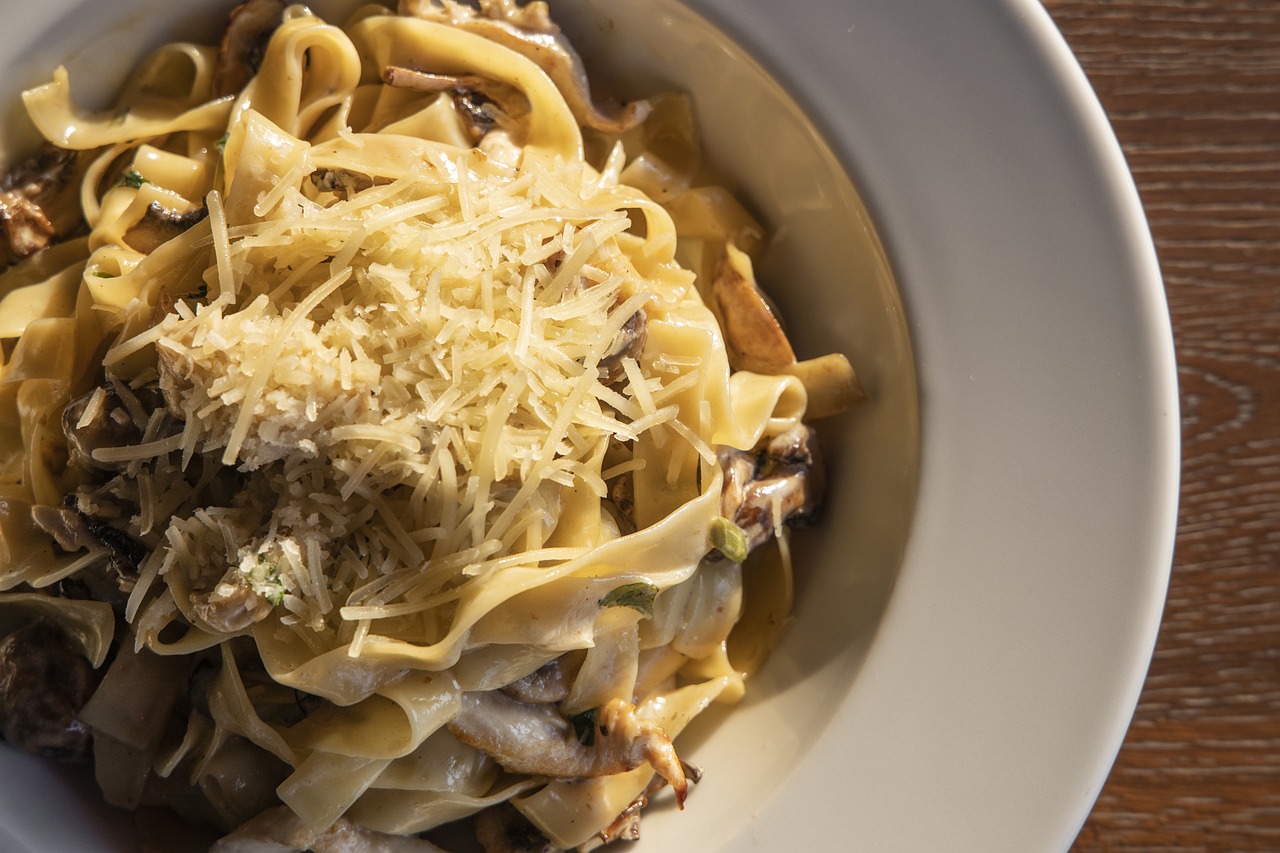
It is not recommended that dogs consume Alfredo due to the fact that its main ingredients (butter onions, butter, and garlic) can be harmful for dogs. A small amount of Alfredo can cause damage to the body of your dog, so it’s not recommended to feed your dog, Alfredo.
Alfredo is famous for its high dairy amount which makes it extremely tasty and creamy in pasta. But, it’s because of this that it can be it dangerous for our furry family members.
What’s Alfredo?
Alfredo is a delicious white pasta sauce composed of thick cream (or heavy whipping cream) minced garlic butter Parmesan cheese, as well as parsley. The best pasta to use for Alfredo is the standard pasta known as Fettuccine. Fettuccine is the ideal kind of pasta to use for Alfredo because it is able to withstand and withstand the weight of cheddar cheese along with butter fat.
What’s it that you are looking for in Alfredo?

If you’ve got one pound of fresh, broad egg pasta, then these are the ingredients that you will need according to the measurement you’ll require:
- 6.25 tablespoons unflavored butter.
- 1.75 cups of 400 milliliters (mL) of heavy cream.
- 8.5 1 ounces or the equivalent of 240 grams of Parmesan cheese (alternatively you can use Asiago cheese).
- 1 tablespoon of salt.
- Pepper black.
- A little fresh grounded Nutmeg.
Let’s talk about these specific ingredients in greater detail, and learn the reasons Alfredo is a danger to dogs.
Butter that is not salted (Not secure)
Butter is generally not suitable for dogs in general. It doesn’t matter whether the butter has been salted, or un salted. Although unsalted butter is the safer choice for dogs however, if your dog has a lactose intolerance (as the majority of canines are) or has a lactose intolerance, then he’s incapable of digesting properly dairy foods. Butter is made of the fat and protein component of milk or cream, and is mostly saturated fat. In reality, it’s 80 percent butterfat.
In terms of calories, butter is 99% fat, with just one percent protein. In 100 grams of butter, nearly 50 grams of saturated fats. For just one teaspoon of butter, it contains 12 grams of fat.
In addition, the fatty acids found in butter don’t provide any health benefits for your pet. The essential vitamins and minerals that are present in this butter could be found in more nutritious pet food.
If you own a 30-pound dog (medium-sized) that’s a lot of dog. He needs around 12 grams of fat each day to sustain a healthy diet. So, even a tiny bit of butter may exceed his daily fat intake. This is the reason why it’s best to not feed your dog any butter at all.
If you have to, offering your pet a small amount of butter on occasion as a treat is the best.
If your dog accidentally licks the butter from the mixing bowl, he will be fine. However, try to keep the butter away from your dog’s reach.
If your dog takes the wrong piece of butter stick or tub of butter it will show the following signs:
- The stomach is upset for 3-4 days.
- Constipation and irregularity of bowel movements that last for 3-4 days.
- Ingestion.
- Gas.
- Bloating.
- Diarrhea.
Contact your veterinarian right away if your four-legged companion is showing these symptoms.
Be sure that this isn’t an ongoing daily habit. Because butter is loaded with calories, regularly eating butter can cause your pet to gain weight. This can result in overweight dogs.
Therefore, it is advised to ensure that you don’t feed your pet Alfredo because it’s packed in butter.
Heavy cream (Harmful)

The heavy cream you buy is a dairy item and like butter, it can be difficult for the body of your dog to properly digest heavy cream. The majority of dogs who suffer from lactose insensitivity don’t have enough lactase enzymes that can digest dairy products such as heavy cream.
If your pet is lactose intolerant and happens to consume heavy cream, here are some signs to look out for:
- Diarrhea.
- Gas is constantly flowing.
- Vomiting.
- Liquid stool or loose stool.
Beware of giving Alfredo to your pet If they are lactose-intolerant overweight, obese, or suffer from diabetes. Alfredo is loaded with thick cream, and isn’t a good choice for pets.
Parmesan cheese (Harmful)
Alfredo has a substantial quantity of Parmesan cheese. This is the reason your dog is advised to stay away of Alfredo.
Parmesan cheese has significant amounts of salt, so it’s not the ideal cheese to give your dog a pet. A high amount of sodium in your dog’s system could cause initial high blood pressure, and then cause organ damage in the future.
Additionally, cheese contains fats that are high in content. People who regularly eat cheese are likely to gain weight and develop obesity. This is why it is important to be sure to keep the Parmesan cheese out of your pet’s access.
Tip: When it comes to cheese, it is important to know that certain cheeses contain herbs or flavorings that can be harmful for dogs, like garlic, onions, and chives. Cheese is designed for human consumption, and some human food items like Pepperoni include the toxic ingredients that could harm the health of your dog.
Asiago cheese (Harmful)
Some people prefer parmesan cheese instead of asiago when making Alfredo. Although cheese is rich in calcium and protein, as well as essential fat acids Vitamin A, B, and C vitamins canines get these health benefits by eating their usual diet for dogs.
If your dog is fond of cheese, then it’s recommended to offer them cheeses with low fat. We’re talking soft goat cheese, cottage cheese, and mozzarella cheese. Cottage cheese is lower in fat and sodium when contrasted with other cheeses like parmesan cheese or asiago. One of the great benefits of cottage cheese is it’s low in lactose making it more digestible.
If you’re replacing parmesan cheese for asiago cheese this means that your Alfredo will be a good source of asiago cheese. It’s ideal to avoid feeding your pet, Alfredo.
Salt (Harmful)

In this instance, if the recipe is Alfredo for one whole pound of fresh pasta then you’ll require one teaspoon of salt. Although the amount of 1 tablespoon isn’t enough to cause poisoning from salt in humans, it could cause harm to your pet and cause hypernatremia and/or sodium poisoning.
The average dog needs 0.25g to 1.5g for every 100g dog’s food. This is considered to be an acceptable amount of salt in the diet of your dog’s.
Feeding your pet Alfredo which has the equivalent of 1 teaspoon salt will be equivalent to 5.9g in salt. As you can observe, this is a lot more salt than what your pet needs.
If you’re cooking Alfredo with this high amount of salt, it’s recommended not to give Alfredo to your furry companion.
The pepper is black. (Mostly safe when used in moderation)
Black pepper is the most common seasoning for Alfredo. Although a tiny amount of pepper is acceptable with dogs. If you spiced the Alfredo with a large amount of pepper from the black variety, make sure to keep Alfredo out of the reach of your pets.
Nutmeg (Harmful)
If you are adding nutmeg to Alfredo, you should avoid feeding it to your dog. Alfredo do not feed Alfredo to your dog. Nutmeg is dangerous to dogs since it is a toxin known as myristicin. The toxin is present in the oil from the seeds of the nutmeg.
Consuming a lot of nutmegs could have adverse consequences for dogs. Even a tiny amount of nuts can trigger these symptoms
- Afraid stomach.
- Vomiting.
- Diarrhea.
- Biting incessantly.
- Hallucinations.
- Get lost or confused.
- Confusion or staring in space.
- He was nipping at her in a furious way.
- Their heart rate is fast.
- Panting or barking.
- Dry mouth, dehydration.
- Lethargic.
- Display behavior that is fearful.
- Muscle spasms or tremors.
If your dog accidentally eats food that is containing nutmeg, be sure to watch closely for a few hours in order to observe if he displays any indications or symptoms. If you notice symptoms of the toxicity of nutmeg and you suspect he is suffering from it, take him to the veterinarian promptly.
Also is it possible for dogs to consume Alfredo?
It’s recommended to not feed your dog food that has Alfredo within it. Alfredo contains dairy products that are difficult to digest for dogs and also has a substantial fat content because of the cream, butter, and cheese that are used. Furthermore, spices and seasonings such as salt and nutmeg can cause poisoning.
Instead of giving your pet Alfredo, choose an option that is more suitable for dogs.

Other Questions
Can dogs eat fettuccine? Alfredo?
Dogs should not be eating Alfredo fettuccine. Fettuccine is a kind of pasta that is long, heavy and shaped to resemble an elongated ribbon. Actually, fettuccine in Italian is a short word that means small ribbons. While cooked pasta fettuccine is safe for dogs to consume however, it’s Alfredo that dogs should not consume. Therefore, dogs can eat fettuccine so long as it doesn’t contain Alfredo inside it.
Make sure that the fettuccine doesn’t contain lots of sugar or salt since each of them may cause stomach upset for your dog. If your dog is not intolerant to wheat, then they may be able to eat fettuccine safely.
Do dogs like pasta Alfredo?
Alfredo noodles indicate that there is Alfredo in the noodles. If this is the situation the answer is no, dogs should be fed Alfredo noodles and must be avoided at all costs.
Can dogs eat Alfredo pasta?
Dogs should not consume Alfredo pasta. Alfredo pasta is made up of Alfredo that is not healthy or safe for dogs. Do not feed your pet Alfredo pasta.
Can dogs eat shrimp fettuccine Alfredo in a dog?
Do not let your dog take in shrimp Alfredo fettuccine. Shrimp fettuccine Alfredo is a term used to describe the fact that the shrimp has been coated in Alfredo which is not suitable for dogs.
Dogs can enjoy plain, fully cooked shrimp, with the shells removed. If it’s cooked together with Alfredo as well as fettuccine it could over-do your dog’s daily caloric requirements. Do not feed your dog any food with Alfredo within it.
Can dogs eat chicken, Alfredo?
Dogs should not eat Alfredo chicken. Chicken Alfredo signifies that there’s Alfredo within the food, and this isn’t helpful for dogs. If the chicken isn’t coated in Alfredo the dish is safe for you to serve your pet.